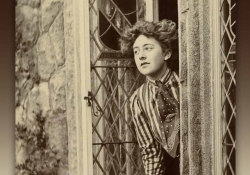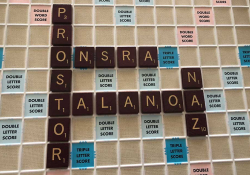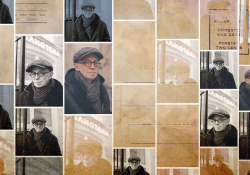Against Neutrality, Capital Letters, and Easy Translation

Whenever I start to translate a Yiddish poem, I worry about capitalization. As in a lot of languages that aren’t English, Yiddish letters (which are the letters of the Hebrew alphabet) don’t grow or shrink depending on their placement in the line, or the propriety of the noun their bodies together form. Instead, certain letters are distinguished by vowels, in the form of diacritical marks, placed around them. Komets-alef looks like this: אָ. It makes an “o” sound farther back in the throat than English speakers are used to. The komets is underneath and the letter on top is the alef, which is silent on its own. When the alef is underscored by the flat line of a pasekh, it makes an “a” sound instead: אַ. In Yiddish, of course, this is perfectly normal. (Also, Yiddish reads right-to-left.)
The myth of English and colonization as perfected by the United States is that normalcy—fitting in—is simple as well as desirable. Assimilation comes easier when translating Yiddish prose, rather than poetry, because the format for an English sentence is relatively standard: begin with a capital letter, end with one of four punctuation marks: . , ! ? Yiddish, being like English a member of the Germanic language family, is made up of sentences that are recognizable as such to a native English speaker, even if the word order is unusual, the nouns are gendered, and certain subtle implications are difficult to convey in translation. But as writer Maggie Nelson notes in The Argonauts, “I had spent a lifetime devoted to Wittgenstein’s idea that the inexpressible is contained—inexpressibly!—in the expressed. . . . Words are good enough. It is idle to fault a net for having holes.”
When I was working on translating Rajzel Zychlinsky’s poems, I asked my Facebook friends the question I’m pondering here: Why choose to capitalize letters in an English translation of a Yiddish poem? One friend, a native Yiddish speaker from Detroit, answered like this: “Not capitalizing is a stylistic choice in English. I would say that not capitalizing is adding a stylistic choice to a poem that didn’t necessarily make that choice (or a similar one). It draws attention away from the form of the poet, the choices she made when writing the poem, which one is attempting to translate into English. Not capitalizing is jarring and immediately obvious to a reader of English, and would make me wonder why it’s happening; if the translator is using nonstandard English, did the poet use analogously non-standard Yiddish? If the answer is no, maybe avoid it?”
Yiddish is more ordinary for my friend because he grew up speaking it. I am always working my way in, afraid to accidentally appropriate or fetishize the language of my own people. But I do want to say this: this same friend from Detroit pointed me with a sigh to the book Foods of the Foreign-born in Relation to Health. Published in 1922 by dietitian Bertha M. Wood from the Boston Dispensary, an organization whose stated purpose was to provide “medical relief of the poor,” the book advises that Jews, despite their fondness for pickles, avoid consuming them in excess as it “destroys the taste for milder flavors [there’s that damn neutrality again!], causes irritation, and renders assimilation more difficult.”

Pickles, an ordinary food for Ashkenazi Jews, were deemed wrong or strange in American culture. The Jews who consumed them didn’t belong. Something totally ordinary in Yiddish (like a lack of capital letters) can’t be represented by an American English analogue; there isn’t one. Even the YIVO Institute for Jewish Research’s standardized transliteration only approximates, and it erases dialectal variations. What’s normal in Rajzel Zychlinsky’s Polish Yiddish isn’t even standard in YIVO Yiddish, never mind American English, though of course there are overlaps. (And I’m writing here about Zychlinsky’s Yiddish in particular, not the Yiddish dialects that are native to the US, the way Yiddish appears in American English, or any other form of influence, overlap, or outgrowth. It’s worth mentioning and remembering that there are multiple Yiddishes, just as there are multiple versions of any language, which makes true fluency impossible.)
American schools teach that a sonnet has fourteen lines, but nonwhite and poor and immigrant children learn not to bring fragrant home-cooked foods for lunch only after they are ostracized.
Poetry, however, can be anything. (Prose can be anything too! But that’s a different essay.)[1] Poetic forms (which include, wonderfully, something called “free verse”) are expansive—infinite, actually. Even standard Western poetic structures—sonnets, villanelles, pantoums—admit themselves to be constructions. The system of poetry is transparent and explicit, not invisible or implied. American schools teach that a sonnet has fourteen lines, but nonwhite and poor and immigrant children learn not to bring fragrant home-cooked foods for lunch only after they are ostracized. As poet Leah Lakshmi Piepzna-Samarasinha mentioned in an interview last summer,
I’m really proud of the working-class poetics in my writing. Marge Piercy said that one part of her working-class aesthetics as a poet is that a lot of the events happen in a really short period of time–there’s not a lot of working-class books where one flower blooms and dies. It’s more like documentation of all the crazy shit happening all the time. So . . . it takes a lot to write a book of poetry, but poems are short and you can write them on the bus. It’s a more class-accessible art form in terms of time. Writing a 300-page memoir, it’s a lot harder to do that on the bus. It takes time.
Working class but also queer, of color, Jewish, trans, disabled, sick, female, to name a few. Not, so to speak, neutral.
Which is to say that when I translate Yiddish poetry, I (mostly) do not capitalize. I love the look of letters on the page, all the same size. How their uniform height allows the shape of the poem to become more visible. How abnormal it appears in English, and how it makes visible the origin language, Yiddish, as well as the work of translation itself. Consider the opening line of Rajzel Zychlinsky’s poem “bring me the blood of the enemy,” first published in 1936: “bring me the blood of the enemy on your knife.” In English, lowercase indicates a continuation. I love imagining this line coming in the middle of a conversation or a directive, only part of which the reader is privy to—even though this is my own interpretive imposition as a native English speaker who learned Yiddish in college.
Of course, lowercase sentences are becoming extremely normal in American English outside of print publication (and even there, e. e. cummings made waves eighty years ago). When a friend emails me and begins all their sentences with capital letters, I get worried; why are they being so formal?
It might be problematic for me to demand politics from Yiddish when it’s also just a factual language in which people live their lives, and one too often turned into a cheap joke—but everything is political. Switzerland’s neutrality has always been anything but.
But it’s true that by refusing to capitalize, I’m bringing a nonnormative or experimental look to the poem, one that the writer might not have intended in Yiddish. “bring me the blood of my enemy,” for instance, is composed of three four-line verses, every other line of which is “bring me the blood of my enemy on your knife.” It’s a regular poem in both its construction and its repetition, but the fact that 50 percent of the poem is an even-keeled intimate request (“my, your”) for physical violence (written, brazenly, by a woman) underscores its power. What a radical use of the standard form! Though I admit that part of my need to trouble the normalization of translation from Yiddish is because I feel like an impostor in a language I wish I had elsewise acquired, or been born to. That I make this choice as a translator and writer, but the academic in me is squeamish. And that it might be problematic for me to demand politics from Yiddish when it’s also just a factual language in which people live their lives, and one too often turned into a cheap joke—but everything is political. Switzerland’s neutrality has always been anything but.
I want a poetics of translation that is not just anti-assimilationist. I don’t want to be against all the time; I want to be. I look here to Jewish American painter R. B. Kitaj’s Diasporist manifestos. Kitaj defined Diasporist art as that which “is contradictory at its heart, being both internationalist and particularist. It can be inconsistent, which is a major blasphemy against the logic of much art education, because life in Diaspora is often inconsistent and tense; schismatic contradiction animates each day.” Kitaj saw himself as a Diasporist Jew, but did not believe that only Jews or the work of Jews could be Diasporist. So how about Diasporist translation?[2] I almost wish I didn’t have to be political about translation, but then I’m not sure why I’d do it at all. As Johanna Hedva writes in the essay “Sick Woman Theory,”
If we take Hannah Arendt’s definition of the political—which is still one of the most dominant in mainstream discourse—as being any action that is performed in public, we must contend with the implications of what that excludes. If being present in public is what is required to be political, then whole swathes of the population can be deemed a-political—simply because they are not physically able to get their bodies into the street.
For me, translation, and specifically translation from Yiddish to English, is a way to make knowable and shared what otherwise would remain separate. By translation I don’t mean erasure, but specificity. Regardless of linguality or fluency, we each have our own languages and stories and histories, our own internal set of references against which we measure the life that moves through us, and the challenge of trying to make those comprehensible to others, or of not trying. Without that, why have poems or poetry? Neutrality is not the answer. In fact it’s toxic, and it’s not even real.
Northampton, Massachusetts
[1] Today I’m using Standard American English prose as a tool to allow you, reader, access to my struggles with Yiddish poetry in translation. It’s frustrating that I have to use a language that is not my native ancestral tongue—nor, likely, is it yours—to convey something about Yiddish to you and to myself (though I’m thrilled that we do share a language at all). It’s frustrating that non-standard English is unofficial, without institutional support or sanction. (But that’s its power too. Would you or I deem to be part of the club that would have us? Well of course lots of Americans must, in order to survive.) So let’s agree that English and whiteness and colonization style themselves neutral, when in fact they’re dangerous. And that for the sake of getting to Yiddish poetry today, we will leave our larger critique of that supposed neutrality for tomorrow.
[2] Kitaj was born in Ohio and died in Los Angeles, though he lived in England for much of his life, thus making himself an exile from the land of his own birth as well.














